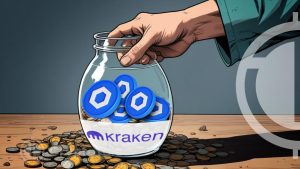
Smart Contracts are a major part of the blockchain that helps automate the execution of functions when set conditions are met. However, its functionality was ultimately limited due to one major drawback: lack of access to real-world data. This limitation was solved with the launch of Chainlink, a decentralized oracle network that connects smart contracts with off-chain data sources. In this article, we’ll discuss Chainlink, its history, use cases, and its workings.
What is Chainlink?
Chainlink can be described as a decentralized platform that operates on the Oracle network. It links smart contracts to the real world through nodes that gather data from off-chain sources. This improves the functionality of smart contracts, allowing them to engage with real-world events such as payments, booking services, and more while maintaining security and reliability. In addition to real-time data, Chainlink also involves off-chain computing and cross-chain interoperability, making it suitable for dApps that must get data from sources beyond the blockchain. LINK is used in Chainlink as a means of payment, most especially to the node operators that provide the off-chain data and services provided on the blockchain system.
The platform is based on the Ethereum blockchain, and its blockchain-agnostic architecture can support various blockchains. Because of its design, Chainlink is also capable of delivering real-world data feeds to various DeFi projects present in various blockchain platforms while maintaining the same level of security as the Ethereum blockchain.
History of Chainlink
Chainlink originally started as a startup called SmartContract in 2014 with the goal of making full use of blockchain technology, especially smart contracts. In 2017, the company rebranded to Chainlink Labs and released the whitepaper for Chainlink, which was co-authored by Sergey Nazarov, Steve Ellis, and university professor Ari Jules.
At that time, smart contracts had no way to access real-world data because blockchains were inherently isolated from external systems for various reasons. This limited the performance of smart contracts, thereby limiting dApps. However, the whitepaper introduced the Chainlink protocol, which included a method of introducing off-chain data into the blockchain in a secure way.
Ethereum Network Growth Hits 4-Month High with 126K WalletsIts ICO was launched in September 2017, raising $32 million in funding, which was used to fund the project. The mainnet of Chainlink started operating in May 2019 on the Ethereum Blockchain. Over the next twelve months, features like Verifiable Random Function (VRF) and Proof of Reserves were implemented to enhance Chainlink’s benefits.
In 2021, Chainlink Labs introduced the Chainlink 2.0 whitepaper. In subsequent years, several other updates were rolled out and were designed to allow the platform to enhance its performance and stay relevant in the crypto environment.
How Chainlink Works?
To obtain data and information from off-chain and into the blockchain, you need the help of different types of smart contracts. They are,
- Requesting Contract: When a smart contract requires real-world data, it sends out a request for information called a requesting contract.
- Service Level Agreement Contract: Chainlink registers this request for real-world data from off-chain as an ‘event’ and creates a matching contract called the Service Level Agreement (SLA) contract.
The service level agreement contract generates three different sub-contracts,
- Reputation Contract: The contract reviews the oracle provider’s track record to verify its authenticity and performance. Only after this process does the smart contract evaluate the nodes and discard the unreliable ones.
- Order-Matching Contract: This contract delivers the request from the requesting contract to the network nodes and collects their bids. From the bids, the order-matching contract selects the appropriate number and type of nodes to satisfy the request.
- Aggregating Contract: It gathers all the data from the chosen oracles and validates it for accuracy. This filtering out of inconsistent data submitted by malfunctioning oracles ensures that the smart contract receives a reliable and accurate result.
Use Cases of Chainlink
Gaming
Software developers have shifted to using Chainlink-based smart contracts to build game apps. These applications function on different blockchains while relying on the oracle network for real-world information and often release limited-edition digital art in the form of NFTs. Moreover, one of the crucial points of the gaming and NFT-based protocols is to create a random number generator to define lucky winners, generate in-game scenarios, and create NFTs. The randomness is provided by the Chainlink in the form of a Verifiable Random Function (VRF). They initiate randomness, pass it through to the smart contract, and assure its authenticity and immunity to alterations by game developers, players, and other third parties.
Decentralized Finance (DeFi)
The entire DeFi space is booming, with thousands of DeFi applications in development or launched. These apps provide services like lending, borrowing, and trading assets. Unlike traditional finance, DeFi apps are more transparent, secure, and easier for anyone to access. They use Chainlink to get the real-time price of assets and interest rates, verify collateralization, and more. This enables them to offer loans, settle options contracts, issue dividends, etc.
Insurance
The insurance field also employs DeFi applications, which are revolutionizing the industry with parametric insurance contracts. Chainlink brings in the needed off-chain data to execute the smart contract. For instance, crop insurance assists farmers in collecting real-time weather data. As a result, when there is a downpour or a drought that affects the crops, the parametric insurance pays for the losses. Furthermore, this method cuts the time taken to make the payment, making it fast and efficient.
Pros and Cons of Chainlink
Pros
- Decentralized Oracle Network: The Oracle network collects data from various sources in the real world, consolidates it in a single location, and confirms its validity. This eliminates the dangers associated with a single source of truth.
- Secure and Reliable: It anonymously provides off-chain data to a smart contract in a blockchain and ensures that nodes with incorrect data are punished in Chainlink.
- Blockchain-Agnostic: Although Chainlink is built on Ethereum’s blockchain, it is integrated into various blockchains and works in any ecosystem.
Cons
- Complexity: The technology behind Chainlink might be rather technical and hard for a new user to grasp. Incorporation of data from an Oracle network into a smart contract requires a good understanding of how the blockchain works.
- Node Operation: Running a node for the Chainlink network requires considerable investment in equipment and a good deal of technical know-how; thus, few people are likely to be able to set up a node.
Conclusion
Chainlink is a functioning decentralized oracle network that helps to connect smart contracts with real-world data, enhancing the decentralized applications’ effectiveness. It has been designed to run on different blockchains while maintaining data integrity and immutability of the data. Chainlink’s use cases can be observed in different markets: DeFi, gaming, and insurance. While Chainlink’s decentralized approach offers high security and reliability, its complexity and the technical expertise required to operate nodes can be a barrier for some users. However, Chainlink keeps on enhancing its utility, hence becoming an integral part of the blockchain space and a major player in the advancement of smart contract execution.














